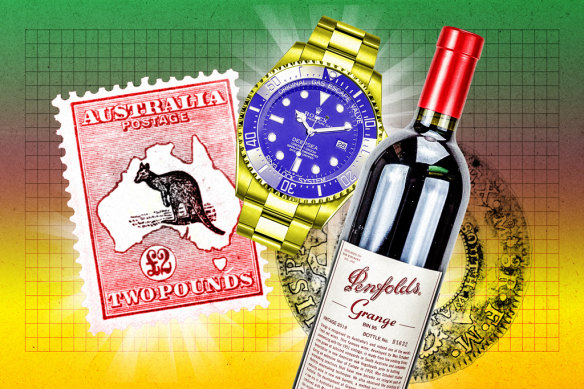Opinion
From Grange to loose change: How to turn your hobby into a money spinner
Dominic Powell
Money EditorReal Money, a free weekly newsletter giving expert tips on how to save, invest and make the most of your money, is sent every Sunday. You’re reading an excerpt − sign up to get the whole newsletter in your inbox.
As a child of the ’90s, I firmly believe we had some of the best collectable crazes. Princess Di collectable plates (RIP), Tazos, Pez dispensers, dolls/action figurines, and, of course, Beanie Babies.
I was too cool/not cool enough to have any of these things (though I did have a brief dalliance with some Mighty Beanz), but at any given week you could guarantee there’d be some new item people were sure would still be worth thousands in the future.

Collectables such as stamps, watches and wine could make you a few dollars.Credit: Michael Howard
However, other than a limited few, almost none of those collectables held their value. Now, I’m not saying that’s true for all ’90s collectables – an Alpha Black Lotus from the Magic: The Gathering trading card game will set you back a cool $US500,000 – but generally, if you put all your super into Beanie Babies, you won’t be living large in retirement.
But there are plenty of collectables that people invest in that do hold their value. These are things such as watches, wine, vintage cars, art, stamps and coins, many of which have proven the test of time and, generally, have a deep market of buyers and sellers. I would also place trading cards in this category, as a combination of popularity and nostalgia has seen very real markets for baseball, Pokémon and Magic cards emerge.
Collectables have also become increasingly popular recently, especially due to the low-interest rate COVID periods, where investors both a) had a lot of time on their hands and b) were keen to find higher-returning assets.
What’s the problem?
Collectables are popular as they let people invest in their hobbies, and can often have significant returns when compared to “standard” assets. But for novices, collectables can pose a challenge. They’re unlike almost any other assets you can invest in, and each type of collectable comes with its own requirements and restrictions. They can also be a headache from a tax/super perspective.
What you can do about it
If you’re curious about investing in collectables, here are some things to consider:
- Collectables are things: Unlike stocks, bonds, or cash (unless you’re stuffing it under the mattress), buying collectables means you’re buying an object. This introduces a raft of considerations you wouldn’t usually need to think about with other investments, including where you’ll store it, the conditions in which you’ll store it, the authenticity of the item (fakes can be rife with certain collectables), and the item’s condition. The difference between a mint condition coin and one that’s even a little bit worn can be in the thousands of dollars. It also adds another layer of concern for things such as fires or floods, as one burst pipe could spell the end of your collection, so insure accordingly.
- Liquidity: While it’s true that some “traditional” investing assets are illiquid, none likely compare to collectables. Selling your 1960 bottle of Grange requires you to find a buyer, either yourself or through an agent or auctioneer, and organise the sale. Buyers for collectables aren’t as plentiful as buyers for other assets, and auctions only run every so often, so selling a collection quickly in the case of an unexpected event can be difficult. It’s for this reason that collectables are usually recommended to be a small part of a broader portfolio.
- Tax considerations: Mark Chapman, director of tax communications at H&R Block, says the good news for collectables investors is if you acquired the item for $500 or less, it is exempt from capital gains tax. This is great if your item appreciates significantly, as the CGT bill for a standard asset would be high, and Chapman says it’s therefore important you keep detailed purchase records so you can prove your cost base if necessary. Capital losses for collectables can also only be deducted against capital gains from collectables, not capital gains from shares or other assets.
- Super fund setbacks: According to the ATO, Australians with self-managed super funds have a collective $642 million of “collectables and personal use assets” in their SMSFs, which is a tiny proportion of the $900 billion in assets held in SMSFs across the country. However, the amount held in collectables has been increasing over time – up from about $400 million in 2019 – so it’s becoming a more popular option. Investors should be wary though, as the ATO imposes heavy restrictions on those who attempt to save on tax by putting their vintage car into a SMSF. Namely, collectables and personal use assets held within a SMSF can’t be used by the owner of the SMSF or any related parties. So you can’t drive your vintage Corvette or display your valuable artwork, and they cannot be stored at your residence. They must also be insured and regularly valued, along with other stringent requirements.
Advice given in this article is general in nature and is not intended to influence readers’ decisions about investing or financial products. They should always seek their own professional advice that takes into account their own personal circumstances before making any financial decisions.